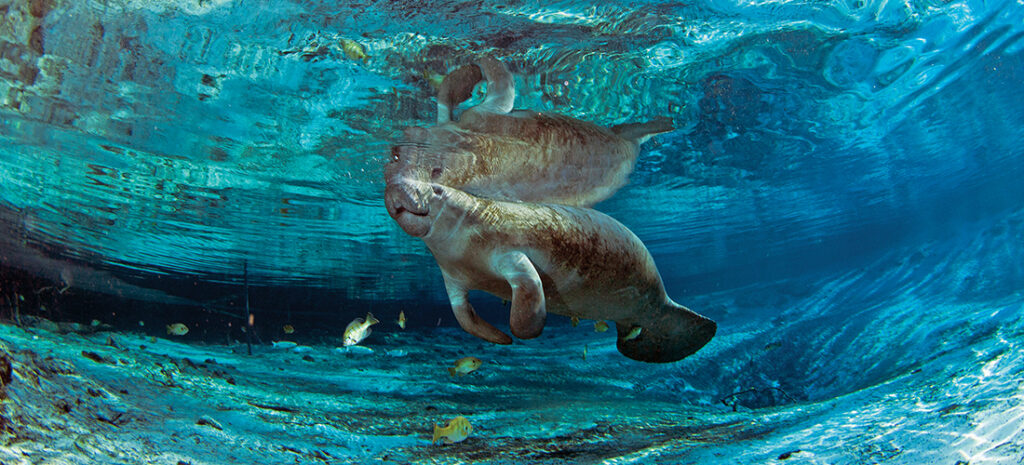Naturalist

How Now Sea Cow
Heeding the ocean’s call
Story and Photographs by Todd Pusser
Some songs just resonate. With his recent passing, Jimmy Buffett’s “A Pirate Looks at Forty” has played on a near continuous loop on my radio. A perennial favorite, its opening refrain strikes a particular chord:
Mother, mother ocean, I’ve heard you call.
Wanted to sail upon your waters since I was three feet tall.
You’ve seen it all, you’ve seen it all.
As a kid, the ocean’s call was powerful. Fed on weekly doses of The Undersea World of Jacques Cousteau, I could not wait to strike out on my own and explore the horizon line far beyond land-locked Eagle Springs. And now, like the middle-aged mariner in Buffett’s song, the feeling of being born in the wrong century and unable to fit into the modern world creeps into the recesses of my mind from time to time. The second verse continues:
Watched the men who rode you, switch from sail to steam.
And in your belly, you hold the treasures few have ever seen.
Most of ’em dreams. Most of ’em dreams.
I frequently find myself daydreaming about those early Victorian-aged explorers who set off on years-long voyages across the globe, imagining their thrill in discovering new lands and encountering unknown animals for the first time. The closest I have come to that enchantment, happened while attending the University of North Carolina in Chapel Hill, where a scuba diving class taken as an elective during my sophomore year introduced me to one of nature’s true marvels. To finalize our certification, we had to make a checkout dive in open waters beyond the gymnasium swimming pool. Over Thanksgiving break that year, the class journeyed down to Crystal River National Wildlife Refuge, along the west coast of Florida, where warm, gin-clear freshwater springs provided the perfect environment to complete the scuba training.
During our first dive, while kneeling on the sandy bottom 20 feet below the water’s surface, a large shadow passed over my head. Glancing up, I saw a wild Florida manatee swimming slowly by. Awestruck, in that moment I felt the same wonder those early naturalists likely experienced when encountering such a large animal for the first time.
It was actually Christopher Columbus who first wrote about the manatees of the New World, in his famed journal from 1492. Having encountered three manatees off the coast of what is now the Dominican Republic, he called them “mermaids.”
For the uninitiated, a Florida manatee is a sofa-sized marine mammal that possesses a broad, paddle-shaped tail, two small flippers and a whiskered face reminiscent of a walrus, minus the tusks. True herbivores, with a propensity for dining on vast quantities of seagrass, manatees are often referred to as “sea cows.”
How Columbus mistook such creatures for the voluptuous sirens of myth and legend is unknown. Granted, he had just spent six long, lonely months at sea, sailing across the Atlantic. Columbus later commented in his journal, more prudently, that “they were not as beautiful as they are painted.”
For such large animals, manatees are quite curious and disarmingly docile. Swimmers and snorkelers from all over the world flock to Crystal River, the only place in the United States it is legal to enter the water with these endangered mammals.
Incidentally, among the staunchest advocates for manatees over the last four decades was none other than that tropical troubadour Jimmy Buffett. In 1981, Buffett joined forces with then-Florida Gov. Bob Graham to form the Save the Manatee Club, a nonprofit organization that continues to this day to campaign for manatee conservation.
Appearing in numerous public service campaigns, Buffett used his immense celebrity to raise awareness for the plight of manatees. He donated money to erect signs throughout Florida waterways warning speeding boaters about the docile mammals; and he was the brains behind the Adopt-A-Manatee Program, an ingenious initiative that engages and inspires the public and has raised millions since its inception in 1984. The adoption model has been so successful that it has been used by numerous conservation groups around the world to raise funds for the protection of other endangered species; everything from whales to gorillas have benefited from Buffett’s genius.
Just this past winter, when a powerful cold front swept out of the Arctic Circle down to the Gulf of Mexico, I visited a waterway next to a nuclear power plant along the shore of Tampa Bay. Despite their large size, manatees lack an insulating blubber layer like that found in whales. As such, the half-ton mammals are particularly vulnerable to cold water temperatures and can quickly suffer from hypothermia.
Hundreds of manatees had crowded into the small canal, where warm water was being discharged by the power plant. Just as many tourists were packed onto a long wooden boardwalk overlooking the canal, gawking at the gentle giants resting in the murky green water. A young boy standing nearby looked up at his father with excited wide eyes and shouted, “Look at all of them!” Followed quickly by, “Wow. Just wow!”
Once again, the ocean’s call was ringing loud and clear. PS
Naturalist and photographer Todd Pusser grew up in Eagle Springs. He works to document the extraordinary diversity of life both near and far. His images can be found at www.ToddPusser.com.
